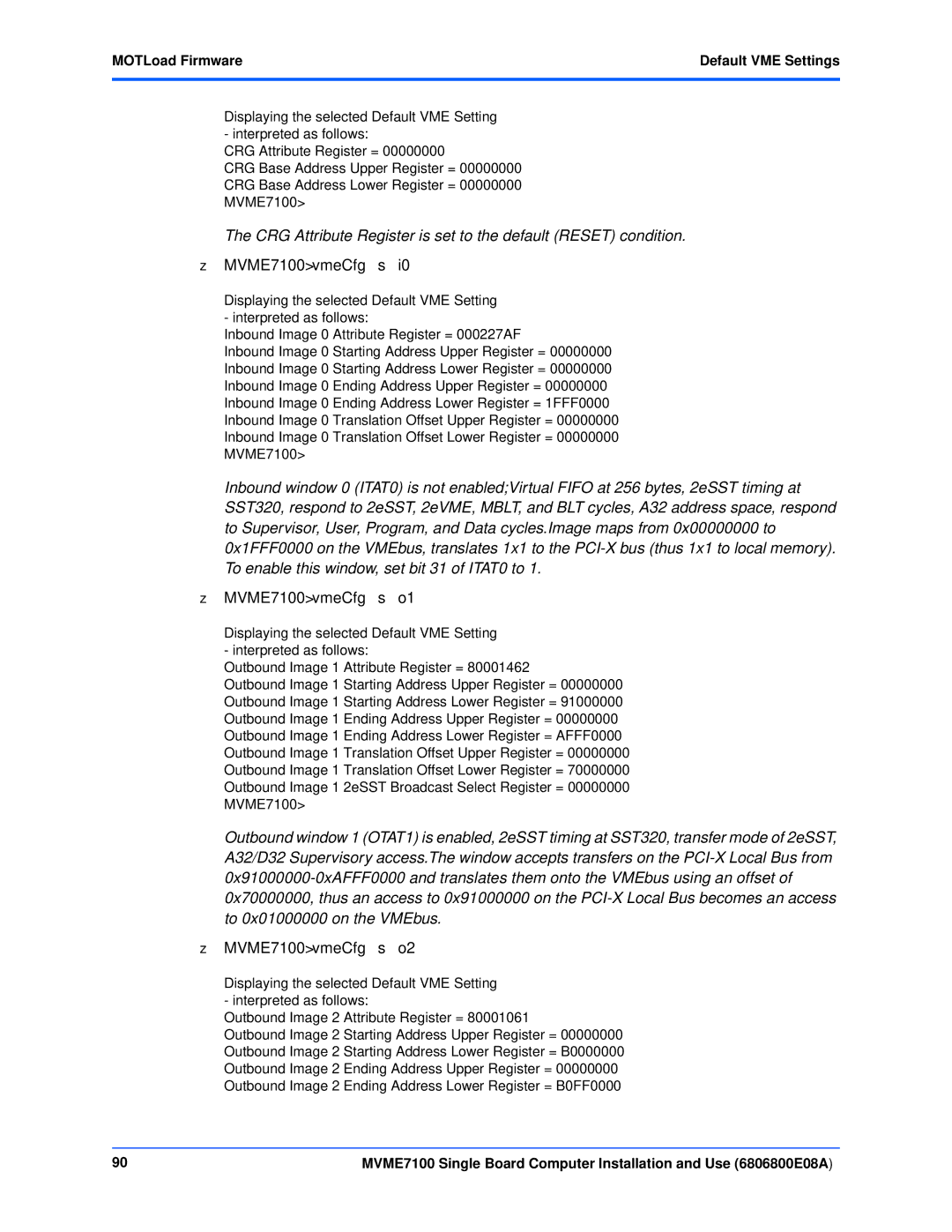MVME7100 Single Board Computer
Contact Address
Contents
Controls, LEDs, and Connectors
Contents
Battery Exchange
Index
List of Tables
Page
List of Figures
Secondary Side Thermally Significant Components
Page
Overview of Contents
About this Manual
Abbreviations
About this Manual
Gpcm
Quart
Conventions
Notation Description
Bold
Summary of Changes
Comments and Suggestions
Safety Notes
EMC
Safety Notes
Installation
Operation
Cabling and Connectors
Battery
Sicherheitshinweise
EMV
Betrieb
Sicherheitshinweise
Kabel und Stecker
Batterie
Umweltschutz
Function Features
Features
Features List
Introduction
IntroductionFeatures
Pcie
Board Standard Compliances
Standard Compliances
Mechanical Data
Mechanical Data
Supported Board Models
Board Accessories
Ordering Information
Board Variants
Startup Overview
Hardware Preparation and Installation
Overview
Task
Unpacking and Inspecting the Board
Shipment Inspection
Characteristics Operating Nonoperating
MVME7100 Specifications
Requirements Hardware Preparation and Installation
Requirements
Board Variant Power
Power Requirements
Power Requirements
Chassis Type Available Power Power With PMCs
Thermally Significant Components
Thermal Requirements Hardware Preparation and Installation
Thermal Requirements
Thermally Significant Components
Primary Side Thermally Significant Components
Equipment Requirements Hardware Preparation and Installation
Equipment Requirements
Configuring the Board
Hardware Preparation and Installation Configuring the Board
SMT Configuration Switch, S1
Configuration Switch Settings S1
Switch Description Setting Function
Safe Start Switch
Position Function Default
Geographical Address Switch, S2
VME System Controller and GA Switch Settings
VME System Controller Select, S2
Position Function Default S2-8
Installing Accessories
Hardware Preparation and InstallationInstalling Accessories
Transition Module
Installation and Removal Procedure
2 PMC
Installation Procedure
Installing and Removing the Board
XMCspan Hardware Preparation and Installation
XMCspan
Installation and Removal Procedure
Completing the Installation
Factory Installed Linux
Page
Controls, LEDs, and Connectors
Board Layout
Reset/Abort Switch
Controls, LEDs, and Connectors Front Panel
Front Panel
Front Panel LEDs
LEDs Controls, LEDs, and Connectors
LEDs
Label Function Location Color Description
Connectors
Baseboard Connectors
Reference Designator Function
XMC Expansion Connector J6 Pin Assignments
Connectors Controls, LEDs, and Connectors
Pin Signal
Ethernet Connectors J4A/J4B Pin Assignments
Controls, LEDs, and ConnectorsConnectors
Pin # 10/100/1000 Mb/s
PCI Mezzanine Card PMC Connectors J11 J14, J21 J23
PMC Slot 1 Connector J11 Pin Assignments
PMC Slot 1 Connector J12 Pin Assignments
PMC Slot 1 Connector J13 Pin Assignments
ConnectorsControls, LEDs, and Connectors
PMC Slot 1 Connector J14 Pin Assignments
PMC Slot 2 Connector J21 Pin Assignments
10 PMC Slot 2 Connector J22 Pin Assignments
11 PMC Slot 2 Connector J23 Pin Assignments
12 COM1 Port Connector Pin Assignments
13 VMEbus P1 Connector Pin Assignments
14 VME P2 Connector Pinouts
Pin P2-Z P2-A P2-B P2-C P2-D
+5V
GND PMC1IO4 PMC1IO3
MVME7216E PMC I/O Module PIM Connectors J10, J14
15 MVME721 Host I/O Connector J10 Pin Assignments
Headers
16 USB Connector J2 Pin Assignments
Controls, LEDs, and ConnectorsHeaders
Processor COP Header P4
Boundary Scan Header P5 Controls, LEDs, and Connectors
Boundary Scan Header P5
18 Boundary Scan Header P5 Pin Assignments
Page
Functional Description
Block Diagram
Functional Description Block Diagram
Processor
I2C Serial Interface and Devices
System Memory
I2C Serial Interface and Devices Functional Description
Timers
Ethernet Interfaces
Local Bus Interface
Nvram
Control and Timers PLD
Flash Memory
Quad Uart Quart
VME Controller 10.2 USB
Duart Interface
PCI-E Port
Functional Description Duart Interface
Power Supplies
XMC Expansion
Clock Distribution
System Clock
Reset Control Logic
Real Time Clock Battery
Real Time Clock Input
Transition Module
Transition Module Layout
Seeprom Address Switch, S1
Transition Module Features
Transition Module Features
Switch Settings and Device Addresses
Rear Panel Connectors
Seeprom Address Switch Assignments RTM
Transition Module Connectors
Transition Module Rear Panel Connectors
Transition Module LEDs
PMC Input/Output Module
PMC Input/Output Module Transition Module
Installing the PIM
Transition Module PMC Input/Output Module
Implementation and Memory Requirements
MOTLoad Commands
MOTLoad Firmware
Utilities
Tests
MOTLoad Firmware
Command List MOTLoad Firmware
Command List
MOTLoad Commands
Command Description
MOTLoad FirmwareCommand List
Command ListMOTLoad Firmware
Using the Command Line Interface
MOTLoad FirmwareUsing the Command Line Interface
Using the Command Line Interface MOTLoad Firmware
MVME7100
Rules
Help
MOTLoad Firmware Rules
Firmware Settings
Default VME Settings
Firmware Settings MOTLoad Firmware
MOTLoad Firmware Default VME Settings
MVME7100 vmeCfg -s
Default VME Settings MOTLoad Firmware
MVME7100 vmeCfg -s -o3
Control Register/Control Status Register Settings
Displaying VME Settings
Editing VME Settings
Deleting VME Settings MOTLoad Firmware
Deleting VME Settings
Restoring Default VME Settings
Remote Start
Boot Images
Name Type Size
MOTLoad Image Flags
Checksum Algorithm
Image Flags
Checksum Algorithm MOTLoad Firmware Name Type Size
User Images
Boot Image Firmware Scan
Alternate Boot Data Structure
Alternate Boot Images and Safe Start
Alternate Boot Data Structure MOTLoad Firmware
Startup Sequence
MOTLoad Firmware Startup Sequence
Battery Exchange
Battery Exchange
Exchange Procedure
Battery Exchange
Manufacturers’ Documents
Emerson Network Power Embedded Computing Documents
Related Documentation
Table B-2 Manufacturer’s Publications
Related DocumentationManufacturers’ Documents
Freescale Corporation
Related SpecificationsRelated Documentation
Related Specifications
Table B-3 Related Specifications
Organization and Standard Document Title
Related DocumentationRelated Specifications
Institute for Electrical and Electronics Engineers, Inc
Index
Transition module PIM installation XMCspan 29
